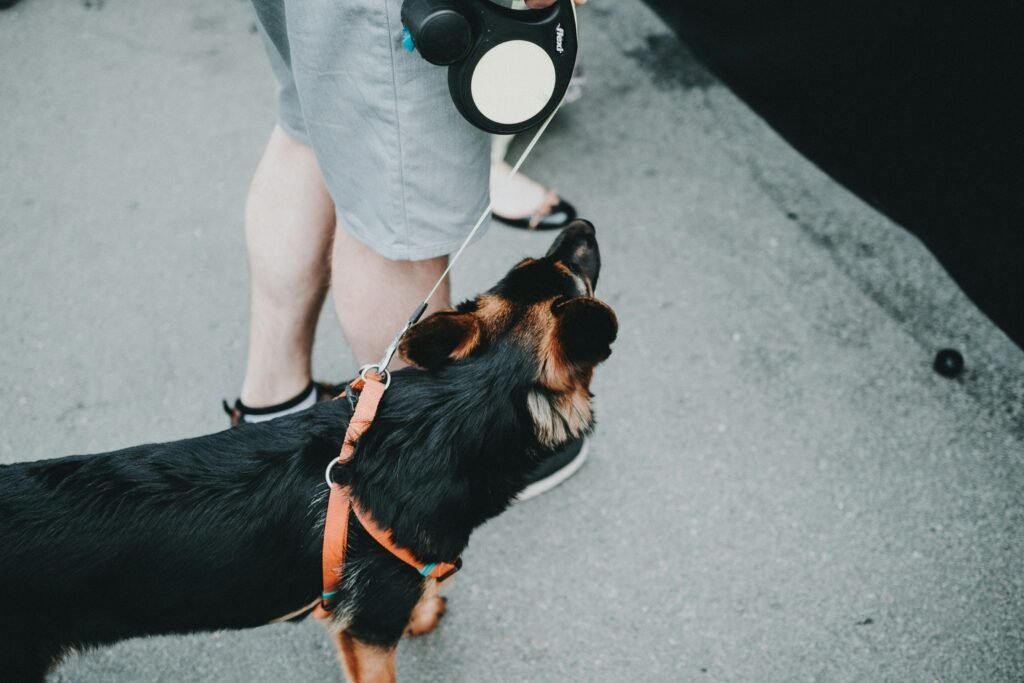Understanding the Problem: Why Dogs Pull on the Leash
Leash pulling is a common challenge faced by dog owners and can stem from various factors related to a dog’s instincts, excitement, and learned behaviors. Understanding these underlying motivations is crucial for effectively addressing this issue. One primary reason dogs pull on the leash is their natural instinctual behavior. Animals often feel a compelling urge to chase moving objects or explore their environments. When walking, a dog may sense scents, sights, or sounds that trigger their predatory instincts, leading them to pull forward in an attempt to investigate or interact with the stimuli. This instinct serves as a survival mechanism in the wild, compelling them to act on their natural curiosities.
Another significant factor contributing to leash pulling is excitement. Dogs, by nature, are highly social and inquisitive beings. As they encounter different environments—a bustling street, other animals, or even people—they may become overly enthusiastic, resulting in pulling reflexively against the leash. This eagerness often signifies their desire to engage with the surroundings, showcasing their liveliness and curiosity. It becomes essential for owners to recognize this excitement as a vital part of a dog’s character rather than a behavioral issue that needs to be corrected.
Furthermore, pulling can also arise from learned behaviors where a dog has not been trained to walk calmly on a leash. If a dog has consistently been allowed to pull, they may perceive this behavior as a successful means of getting to their destination. Training methodologies focusing on positive reinforcement can effectively counteract this behavior by teaching a dog that walking without pulling can be more rewarding than the alternative. By understanding the root causes of leash pulling, dog owners can implement tailored training techniques to encourage a more controlled and enjoyable walking experience.
Choosing the Right Equipment: Tools for Leash Training
Training a dog to stop pulling on the leash begins with the selection of appropriate equipment tailored to the dog’s specific needs. The choice of gear can significantly influence the training process and ensure a more enjoyable experience for both the dog and the owner.
One of the primary tools available for leash training is the dog collar. There are several types of collars, but it is essential to choose one that is designed to minimize pulling. A flat collar is suitable for most dogs and attaches easily to the leash, but some owners may find that a martingale collar, which tightens slightly when the dog pulls, offers better control without causing discomfort.
Another option is the head halter, which fits over the dog’s muzzle. This device allows the owner to direct the dog’s head, making it easier to manage pulling behavior. However, it is crucial to introduce the head halter gradually to avoid overwhelming the dog. Additionally, some dogs may respond better to harnesses, particularly those designed specifically for leash training. Front-clip harnesses can help discourage pulling by redirecting the dog’s movement and promoting proper walking behavior.
When selecting a harness, the size and breed of the dog should be taken into consideration. Larger breeds may require sturdier harnesses with strong clips, while smaller dogs might benefit from lightweight options that prevent discomfort. The leash itself also plays a vital role in leash training. Opt for a standard leash rather than a retractable one, as a fixed leash offers more control and can help reinforce training techniques.
Overall, using the right equipment for leash training can enhance the effectiveness of the techniques applied. By evaluating the dog’s behavior and size, owners can determine the best combinations of collars, harnesses, and leashes to ensure successful training and foster a more pleasant walking experience.
Basic Commands for Leash Training: Teaching Your Dog
Establishing a firm foundation in leash training requires teaching your dog essential commands. The commands “heel,” “stay,” and “let’s go” serve as pivotal tools in managing your dog’s behavior while walking. By integrating these commands into your training sessions, you can promote a more pleasant walking experience and reduce pulling on the leash.
The first command, “heel,” instructs your dog to walk closely by your side. To teach this, begin in a quiet space with minimal distractions. Hold a treat in your hand, and let your dog sniff it. As you take a step forward, encourage your dog to follow by saying “heel.” When your dog matches your pace, reward them with the treat and verbal praise. It is important to practice this command regularly, gradually increasing the duration and distance walked while maintaining the heel position.
The second command, “stay,” reinforces the concept of control and patience. Initiate by having your dog sit. With a treat in your hand, say “stay” and take a short step back. If they remain seated, immediately return to them, reward them, and praise their good behavior. Gradually extend the distance and duration of the stay command to further enhance their focus and discipline.
Finally, “let’s go” is an essential command that can help redirect your dog’s attention during walks. Start by using this command before you begin moving. Say “let’s go” in an enthusiastic tone, and start walking. Whenever your dog pulls ahead, stop walking and wait for them to return to your side. Once they do, reinforce the command with praise and treats. Consistently practicing these commands during your walks will reinforce proper behavior, making the experience more enjoyable for both you and your dog.
Positive Reinforcement: Rewarding Good Behavior
One of the most effective techniques to stop your dog from pulling on the leash is the implementation of positive reinforcement. This method focuses on rewarding desirable behaviors, enabling your dog to understand what is expected during walks. By reinforcing calm walking beside you, you create a positive association with being close and attentive.
To begin with, it is crucial to have a variety of rewards on hand. These can include treats, praise, or playtime, depending on what motivates your dog the most. While some dogs respond well to food treats, others may prefer verbal affirmations or a brief game with their favorite toy. Identifying what your dog values serves as the foundation for effective positive reinforcement.
During walks, when your dog walks calmly beside you without pulling, immediately offer a reward. This could be a small treat or a few words of encouragement such as “good boy” or “good girl.” The timing of the reward is essential; it should be given as soon as the good behavior occurs, which helps your dog make the connection between the action and the reward. For instance, if your dog stays at your side for an extended period, pause, reward them, and then continue walking. This reinforces that staying close is desirable and leads to positive outcomes.
Consistency is fundamental when using positive reinforcement. Always reward your dog for calm behavior to help solidify this expectation. Over time, your dog will learn that walking on a loose leash results in positive experiences, diminishing the tendency to pull. Additionally, varying the type of rewards can keep your dog engaged and motivated throughout your walks, making each outing a delightful adventure for both of you.
Leash Training Techniques: Methods to Stop Pulling
Effective leash training is essential for establishing a peaceful walking experience for both you and your dog. One of the most significant challenges dog owners face is their pet pulling on the leash. Several training techniques can help curb this behavior, ensuring that your walks are enjoyable. Three notably effective methods include the stop-and-go method, the redirection method, and the ‘turn around’ technique.
The stop-and-go method is a straightforward approach where the owner intermittently stops walking when the dog pulls ahead. When the dog reaches the end of the leash, halt immediately and stand still. This method teaches the dog that pulling does not lead to forward movement. Wait until they return to your side or loosen the leash to continue walking. By consistently applying this technique, dogs learn to associate loose-leash walking with progress. It is particularly effective for young and energetic dogs excited by their surroundings.
The redirection method involves capturing your dog’s attention when they start to pull. Equip yourself with treats or a favorite toy. When your dog begins to tug, calmly redirect them with the treat or toy, enticing them to return to your side. This approach reinforces positive behavior while giving them an alternative focus. Timing is critical; be sure to offer the reward immediately when they are walking without pulling. This technique not only reduces pulling but also strengthens the bond between owner and pet through positive reinforcement.
Finally, the ‘turn around’ technique is another effective method to discourage pulling. When the dog pulls, turn in the opposite direction and walk away from the direction they were headed. This strategy confounds the dog, teaching that pulling results in the loss of forward movement. When they follow without pulling, promptly provide praise or a treat. This technique can be particularly helpful in environments with numerous distractions, as it encourages the dog to stay engaged with you rather than follow their instinct to rush.
Consistency is Key: Developing a Routine
Establishing a consistent routine is crucial for teaching your dog proper leash manners. Dogs thrive on predictability, and a well-structured walking schedule helps them understand the expectations set during training. Begin by choosing specific times throughout the day for walks, ensuring that your dog becomes accustomed to regular outings. This can reinforce their understanding that leash walking is part of their daily routine, and anticipation can aid in reducing pulling behavior.
When walking your dog, consistency in your approach and commands is essential. Use the same cues each time, such as “heel” or “let’s go,” to signal when it is time to walk calmly. This familiarity aids your dog in recognizing what is expected of them. Consistent practice fosters an environment where your pet learns to engage positively with leash walking, as they will associate these commands with the expected behavior over time.
Additionally, consider varying the walking routes on occasion while maintaining the same principles of training. A change in scenery can invigorate your routine and keep your dog mentally stimulated, which is equally important for reducing anxiety that may lead to pulling. Integrate pauses during walks where you require your dog to sit or stay upon encountering distractions. This not only reiterates your control but also creates a clear understanding of acceptable behaviors during walks.
Finally, remember that consistency applies to all family members involved in walking the dog. Everyone should follow the same guidelines and commands to avoid confusion for the dog. Over time, as your dog experiences a solid routine and clear expectations, you will likely see a reduction in pulling behavior and an overall improvement in leash manners.
Common Mistakes to Avoid: What Not to Do
Leash training is a fundamental skill for any dog owner, but several common mistakes can hinder the process. One of the most detrimental errors is the use of punishment. Many owners may resort to harsh corrections or reprimands when their dog pulls on the leash, believing that this will deter the behavior. However, punishment often leads to fear and confusion, ultimately damaging the bond between the owner and the dog. Instead, positive reinforcement techniques should be adopted, encouraging desired behaviors rather than punishing unwanted ones.
Another prevalent mistake is the inconsistency of commands. When training a dog, it is crucial to use the same cues consistently. Mixing verbal commands or hand signals can confuse your dog, making it difficult for them to understand what is expected. For instance, if one family member uses “heel” and another uses “come here” for the same action, the dog will struggle to learn effectively. Clear and consistent communication amongst all family members is essential to reinforce learning and build trust.
Additionally, selecting ineffective tools can lead to frustration. Many dog owners might choose equipment that does not suit their pet’s behavior. For example, using a regular collar on a strong puller can cause discomfort and does little to correct the pulling. Opting for specialized tools like front-clip harnesses or head halters can provide better control and comfort, making the training process more enjoyable for both the dog and owner. Understanding your dog’s specific needs and the appropriate equipment is crucial for successful leash training.
By being mindful of these common mistakes—punishment, inconsistent commands, and ineffective tools—dog owners can create a more productive training atmosphere. This, in turn, enhances the likelihood of successfully teaching their pets to walk calmly on a leash.
When to Seek Professional Help: Knowing Your Limits
Despite the various techniques available to help curb your dog’s pulling behavior on the leash, there are circumstances where you may find it challenging to achieve the desired results on your own. If you have diligently applied the recommended strategies and are still experiencing persistent pulling, it may be time to seek the assistance of a professional dog trainer. Recognizing when to reach out for expertise is crucial not only for your peace of mind but also for the effective training of your dog.
One of the primary indicators that you might need professional help is if your dog exhibits aggressive or overly reactive behavior towards other dogs or people while walking. In such cases, a professional can provide you with specialized guidance tailored to your dog’s unique behavioral issues. Additionally, if you notice that your dog appears excessively anxious or fearful during walks, engaging a trainer with experience in anxiety management can make a significant difference.
When searching for the right trainer, consider their qualifications and experience particularly in dealing with leash manners. Look for trainers who employ positive reinforcement techniques, as these methods are effective and promote a healthy bond between you and your pet. Reading reviews and asking for recommendations from friends or local veterinarians can help you identify reputable trainers in your area. Make sure to interview potential trainers to discuss their approach, ensuring it aligns with your principles and your dog’s needs.
During training sessions, expect to participate actively in learning effective reinforcement techniques and communication strategies. A good trainer will not only work with your dog but will also empower you with the tools and knowledge necessary to reinforce positive behaviors at home. This collaborative effort can lead to a gradual improvement in your dog’s leash manners and strengthen the owner-dog relationship.
Maintaining Progress: Long-term Strategies for Success
Consistent reinforcement of leash training is key to maintaining your dog’s progress and ensuring that walks remain enjoyable. One effective approach is to establish a regular schedule for leash training sessions, ideally incorporating short, focused practices into your daily walks. Consistency helps reinforce the desired behaviors, making it easier for your dog to remember and apply what they have learned. Aim for specific intervals throughout walks where you can practice commands such as “heel” or “let’s go.” Frequent, positive reinforcement during these moments will solidify your dog’s understanding and compliance.
Moreover, it is crucial to address potential relapses promptly. It is not uncommon for dogs to revert to pulling behaviors, especially in distracting environments. When this occurs, maintain a calm demeanor and redirect your dog’s focus. Utilize clicker training or verbal praise when your dog walks nicely beside you to encourage good behavior. If relapses happen, do not resort to punishment, as this may cause anxiety, further complicating the training process. Instead, reassess your training techniques and make necessary adjustments to enhance your approach.
To ensure your walks remain enjoyable for both you and your dog, incorporate varied routes and experiences. Exposure to new environments can stimulate your dog mentally and prevent them from becoming bored. Additionally, consider using engaging tools or toys during walks to keep your dog motivated. Interactive playtime before a walk can also help expend some of your dog’s energy, leading to a calmer walking experience.
Ultimately, both patience and regular practice make a significant impact on maintaining your dog’s leash training progress. With these long-term strategies in mind, you can create a positive walking routine that fosters good behavior and builds a stronger bond with your canine companion, ensuring that both you and your dog enjoy your outdoor adventures together.






